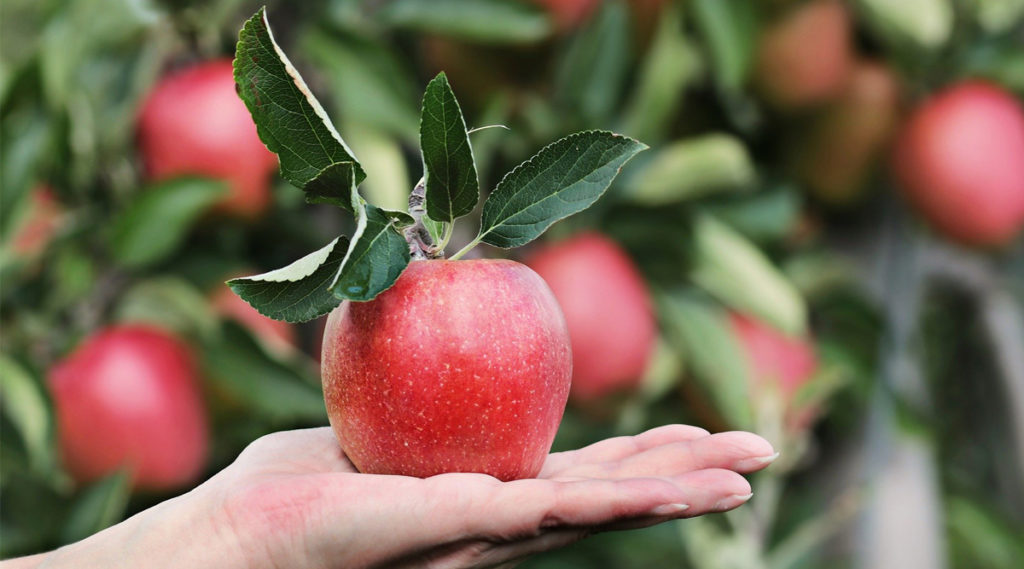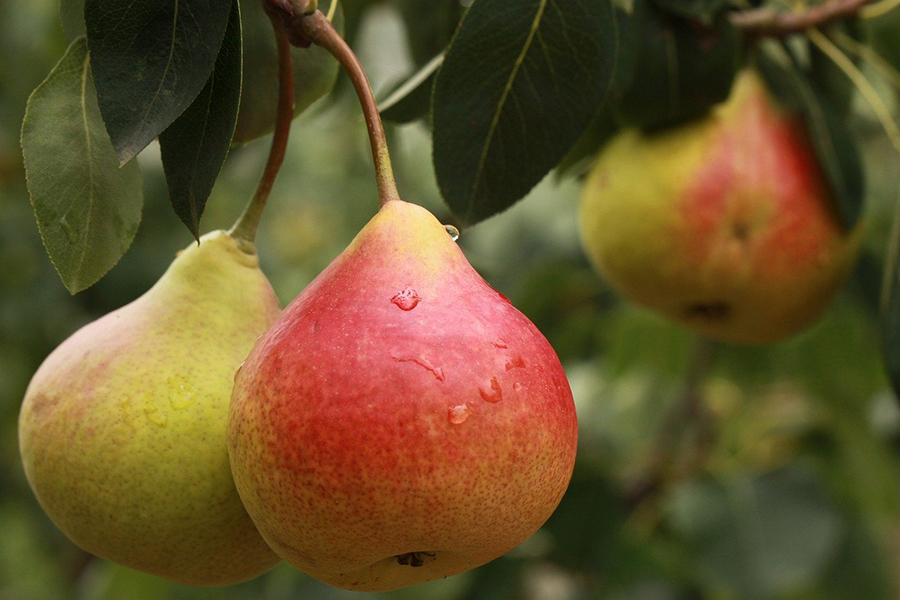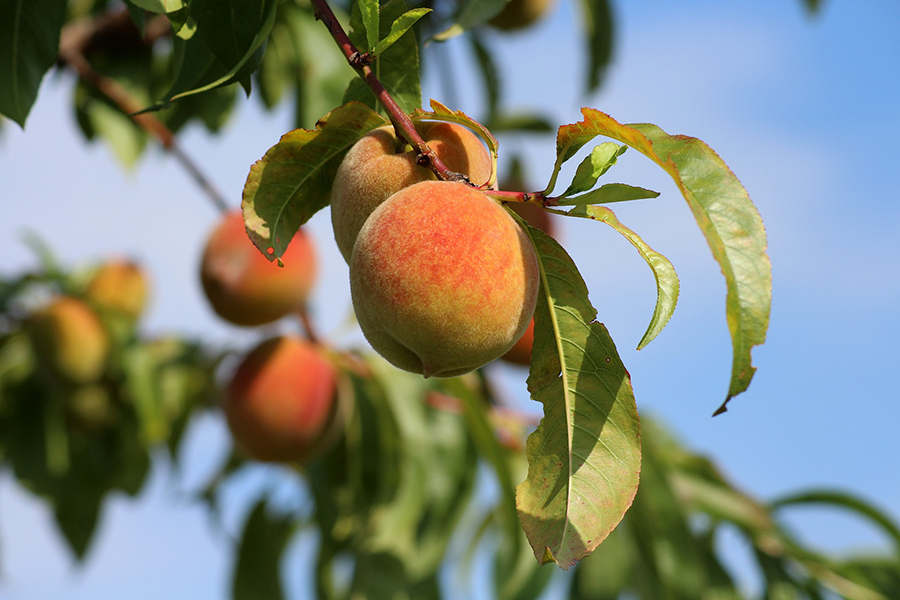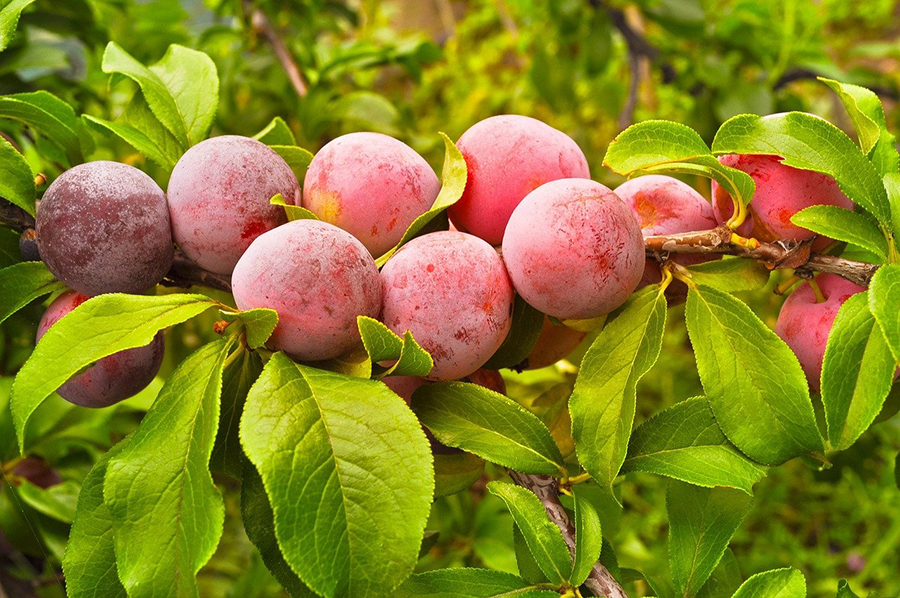Fruit Trees in Arkansas

Keep reading for details on growing fruit trees in Arkansas!
Home gardening as a hobby experienced huge growth last year and we are expecting this trend to continue. With this trend in mind, and knowing that many in our community are interested in either adding onto their ‘grocery’ garden or getting started, we are going to focus more this spring on vegetable, small fruit and tree fruit gardening.
Our fruit trees, blueberries and brambles arrived this week, earlier than ever, so you can start planting now! For details on growing blueberries in Arkansas, follow this link. This particular post is about fruit trees, specifically ones that can grow successfully in Arkansas. Follow these links for other fruit posts:
How to Grow Blueberries in Arkansas
How to Grow Blackberries in Arkansas
Fruit Tree Terms
Self-pollinating trees (also known as self-fruitful or self-fertile) are pollinated by pollen from another flower on the same tree or even the by pollen from the same flower. The benefits of self-pollinating trees is that you only need one to get fruit. However, having an additional tree of the same type, such as two self-pollinating trees, will often result in better yield. A good example of this is Santa Rosa plum. These trees are considered partially self-fertile.
Some fruit trees require cross pollination (these are also known as self-unfruitful or self-sterile), and need to be planted near a different variety of the same tree species with similar bloom time. Another tree of the same variety will work for some fruit trees.
Fruit trees with pits, including peaches, plums and nectarines, are referred to as stone fruits. Freestone is another term you will see below; freestone peach varieties have fruit that falls right off the pit when ripe. Clingstone peaches have fruit that clings to the pit.

Fruit Tree Growing Tips
Fruit trees need full sun, which is at least six hours of direct sun. They also need room to grow so take note of mature size of your new fruit tree before planting. Good air flow cuts down on disease and insect issues so consider this before planting as well.
Once planted, water as needed, avoid over or underwatering your tree. Plant in soil that is well-drained. We say that a lot because most plants need this kind of soil. Basically, it means that the soil doesn’t hold onto too much water. We have some clay soils around here and depending on how much clay is in your soil, it could be poorly drained, the excess water cutting off oxygen to tree roots. Adding organic matter at planting is recommended, and we suggest using Good Earth Jump Start as well to get the roots established faster.
Fertilizing of fruit trees will help overall tree fruit as well as fruit production. Fertilize twice a year with Ferti-Lome Fruit, Citrus and Pecan Tree Food. Follow label instructions for rates and timing. Apply in the drip line of the tree and water in.
As with growing vegetables, monitoring for disease and insect issues is part of successfully growing fruit trees and small fruits. Although more and more varieties are disease resistant, this doesn’t mean they won’t get any diseases. For example, all peaches are prone to disease and will most likely need to be treated at some point. Monitor and address issues as they arise. We carry Bonide Fruit Tree Spray which is an all-in-one disease and insect spray plus spreader sticker to increase absorption. Always read label instructions and follow carefully.
A Few More Fruit Tree Tips
Pruning of fruit trees is necessary for a variety of reasons including shaping, training, increasing light for higher yields, controlling the tree size and the removal of dead branches. This is a pretty big topic; the University of Arkansas Division of Agriculture Cooperative Extension Service has a great fact sheet on this. Follow this link for detailed fruit tree pruning information.
One other item to note; many fruit trees have been grafted. This is when the root system, or root stock, portion of the plant is different than the top growth of the plant. Trees are grafted to produce a stronger plant; varieties with a strong root system are chosen as root stock. A variety with desirable fruiting traits is chosen for the top growth. The result is the best of both worlds, so to speak.
One effect of grafted trees is that there are often dwarf or standard sizes of the same type of plant. As an example, not all Santa Rosa plums are standard OR dwarf, it depends on root stock chosen. Dwarf fruit trees will be labeled as such. Unless a tree is labeled as dwarf, then it is a standard growing tree. Semi-dwarf trees are also available with some varieties.
Fruit Tree Resources
We mentioned the University of Arkansas Division of Agriculture Cooperative Extension Service above in the section about pruning. They have a variety of other fact sheets on home tree fruit production as well. Here is a link to that page; it’s worth a visit for sure. And of course, our team is here to help you keep growing too. Email, call or come by The Good Earth for answers to your questions!
Fruit Tree Varieties
This is not an exhaustive list; instead, it’s a list of fruit trees that can grow well here in central Arkansas and ones we typically carry. Soils are different around the state and so are average last frost dates. We get fruit trees in the spring and fall; we suggest shopping during these seasons for best selection. As you might guess, the best time to plant fruit trees in Arkansas is either spring or fall.
Peach
- Belle of Georgia – Self-pollinating, disease resistant*, freestone, red fruit color
- Scarlet Prince – Self-pollinating, freestone, Southern standard for peach, large fruit, yellow-red fruit color
- Red Haven – Self-pollinating, freestone, disease resistant to leaf spot*, red fruit color, late blooming to avoid frosts
- Contender – Self-pollinating, freestone, yellow flesh. Red skinned fruit is firm and resists browning and bruising. Matures mid season
- Crimson Lady – Self-pollinating, clingstone, yellow flesh. Large fruit is firm and better than most peaches for storing. Matures very early.
- Bonfire Patio – Self-pollinating, clingstone, grown primarily as an ornamental tree, insignificant fruits, stunning pink blooms and eye-catching purple foliage
- Bonanza Patio – Self-pollinating, large pink blooms, freestone, genetic dwarf tree (4-5 ft tall and wide), yellow- red fruit color
*Please note that even disease resistant varieties can experience disease issues. Monitor and treat as needed.
Plum
- Santa Rosa – Self-pollinating but crop yields increase with pollinizer tree, freestone, grows to 10 ft tall and wide, good fruit producer, purplish skin and yellow fruit color, sweet fruit, keeps well, Japanese plum, heat tolerant
- Au Rosa – Self-pollinating but crop yield will increase with pollinizer tree such as Methley, highly disease resistant*, good flavor
- Methley – Self-pollinating, clingstone, sweet purple-red fruit, heavy bearer, disease resistant to fungal diseases like rust*, good pollinizer for other Japanese plums such as Santa Rosa, heavy fruit producer, heat tolerant
- Bruce
- Ozark Premier
Persimmon
- Fuyu – Self-pollinating but produces larger crop when planted with a cross pollinizer tree, mildly sweet with great flavor, tough fruit tree that does well in Arkansas, heat tolerant, large fruit yields, seedless when not pollinated, fruits keep well
- Suruga (first year carrying)- Self-pollinating and astringent. Late ripening with exceptionally sweet fruit
- Tanenashi- Self-pollinating. Fruit can be eaten while firm like an apple but is sweeter after cold weather softens the fruit to a jelly like consistency.
Pear
- Kieffer – Self-pollinating but requires cross pollinizer tree (another Kieffer will work) for good yield, heavy bearing, tolerant of drought, resistant to fire blight*, big yellow fruit with a coarse texture
- Bartlett – Requires pollination by another pear, produces abundant fruit, good for fresh eating, canning and cooking, fast growing
- Shinko- Requires pollination by another Asian pear, also called an apple pear because of the apple shape, medium fruit size, resistant to fire blight*, crisp, sweet fruit
- Ayers – Self-pollinating but will produce higher yield with a cross pollinizer tree, also called sugar pear because it’s candy sweet, fire blight resistant*, medium yellow fruit with a red blush
- Moonglow- Self-pollinating and good pollinator. Newer variety with very good resistance to Fireblight. Great for eating fresh as well as preserving.
Apple
- Yellow Delicious – Self-pollinating and a good pollinizer for other apples, mild, sweet taste
- Red Delicious – Requires a cross pollinizer tree such as Gala, mild taste, outstanding red color, best eaten fresh, doesn’t hold up well to cooking
- Granny Smith – Required a cross pollinizer such as Red or Yellow Delicious, great for fresh eating, baking and cider, bright green color
- Fuji – Requires cross pollinizer tree (Gala, Golden Delicious, Red Delicious, Jonathan), very popular fresh eating apple, stores well
- Arkansas Black – Self-pollinating produces higher yield with across pollinizer tree, disease resistant*, late maturing, stores well
- Gala – Somewhat self-pollinating but another apple is highly recommended. Red fruit is crisp and very sweet.
- Jonathan – Self-pollinating but another apple is highly recommended. The crisp, red fruit is sweet and tart. Good eaten fresh or cooked. Heirloom variety from the early 1800’s.
- Stayman Winesap – Requires a pollinator, does not act as a pollinator. The red fruit is crisp and sweet with a good tang. Heirloom variety from 1700’s with good to moderate disease resistance.
Pecan
- Desirable – Requires a cross pollinizer tree (such as Stuart or Choctaw), heavy producer of large, sweet pecans, papershell
- Choctaw – Plant with a cross pollinizer tree (such as Stuart or Desirable) for best yields, papershell, disease resistant*
- Stuart – great pollinizer for other pecan trees, papershell, long lived pecan tree variety, medium pecans
Fig
- Brown Turkey – Self-pollinating, hardy in our area, produces brown fruit in late spring and late summer, delicious fresh, in preserves or dried, heat tolerant
- LSU Purple – Self-pollinating, produces purple fruit with white flesh, mild and sweet flavor, high producer, disease and pest resistant*
- Celeste – Self-pollinating, heat tolerant, pest (closed eye helps reduce insect issues) and disease resistant*, medium size sweet fruit
- Miss Figgy
*Please note that even disease resistant varieties can experience disease issues. Monitor and treat as needed.

